From Woodland to Wetland:
The Diversity of Serpentine Plant Communities
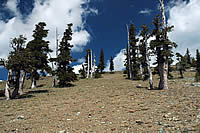
Foxtail pine subalpine woodland, South China Mountain. Photo by Carl Skinner.
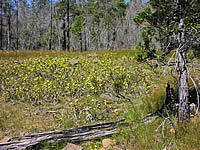
Darlingtonia community on the L. E. Horton Research Natural Area. Photo by Sydney Carothers.
It is crystal clear when you have entered the serpentine realm. There is no mistaking it, as the vegetation shift is sharp and dramatic. Full-canopied forests become sparse woodlands or barrens sometimes in a matter of a few feet. Dwarfed trees, low-lying shrubs, grassy patches, and rock characterize the dry, serpentine uplands. Carnivorous wetlands, meadows, and Port-Orford-cedar dominated riparian areas express the water that finds its way to the surface through fractured and faulted bedrock.
Certainly, the gradient is steep when walking from non-serpentine to serpentine, but this is also evident on a regional basis as one moves from east to west within the Klamath-Siskiyou serpentines. The regional differences are attributed to a moisture gradient, drier climate inland compared to near the coast, but also elevation and the age of exposure with the eastern-most terrain being oldest in the sequence of accretion events.
Exemplary plant communities along the regional age, moisture and elevation gradient include:
- Sub-alpine and Montane Communities on the eastern edge of the Klamath-Siskiyous with 30 to 70 inches of annual precipitation standing 3,600 to 9,000 feet,
- Shrubland and Dry-Site Jeffrey Pine Communities with 40 to 60 inches of annual precipitation at 300 to 5,200 feet, and
- Closest to the coast, the Mesic Jeffrey pine-Idaho Fescue Communities and Darlingtonia terrace fens at 1,650 to 4,700 feet with 80 to 120 inches of annual precipitation.
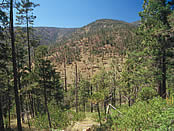
A Jeffrey pine serpentine shrubland on the Siskiyou National Forest. Photo by Lee Webb.
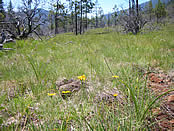
Jeffrey pine savanna with Senecio hesperius, a rare serpentine endemic, in bloom, Siskiyou National Forest. Photo by Maureen Jules.
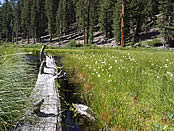
A wet meadow with Tofieldia occidentalis. Photo by Steve Matson.
Serpentine Communities of the Klamath-Siskiyou Mountains
Vegetation patterns in Klamath-Siskiyou bioregion are remarkably complex. Consider the combination of factors affecting the vegetation in any one place:
- Complex geologic history, resulting in a wide array of different substrates surfacing repeatedly across the landscape
- Great diversity in elevation and landforms, from near sea level to over 9,000 feet
- A Mediterranean climate, which by itself is strongly associated with great floristic diversity
- A distinct rainfall and temperature gradient, from the maritime-influenced coastal western slope of the Klamath Ranges to the dry and very hot interior foothills
- The geographic position of the Klamath-Siskiyou bioregion, situated to combine elements of the boreal flora from the north, the California flora from the south, and the Great Basin flora from the east
- Great age of exposure, meaning that the Klamath-Siskiyou bioregion has been available as a home for plant life for a long, long, unbroken period of time.
Even if we choose to look at just the serpentine part of the substrate spectrum, is it any wonder that the vegetation is so hard to classify into neat categories? Still, we try to describe typical serpentine plant communities, as you see here, recognizing that there are many variations and that the communities blend and intermingle with each other.
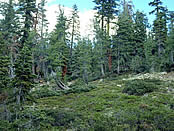
A montane mixed conifer community on the Siskiyou National Forest. Photo by Julie Kierstead Nelson.
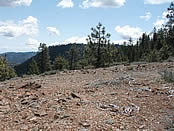
Pyroxinite barrens. Photo by Susan Erwin.
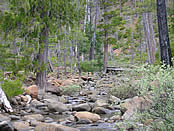
Del Norte willow (Salix delnortensis) growing with Port-Orford-cedar along the upper tributaries of Josephine Creek, Siskiyou National Forest. Photo by Maureen Jules.
Next: Conserving the Botanical Richness of Serpentine Communities »
|







